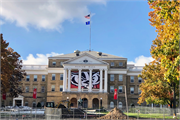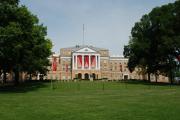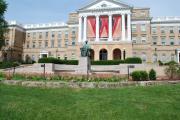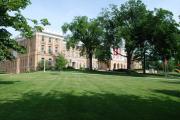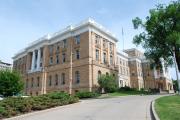| Additional Information: | Two 'site files' exist for this property named 'Bascom Hall' and 'Bascom Hill Historic District'. They contain additional information such as correspondence, newspaper clippings, or historical information. They are publics record and may be viewed in person at the Wisconsin Historical Society, State Historic Preservation Office.
1894 - semi-circular portico was removed. 1895 - present Jeffersonian portico was added and dome enlarged. 1916 - dome destroyed in a fire. 1920 the building was named Bascom Hall in honor of John Bascom, UW president.
University Hall is contributing to the Bascom Hill Historic District, NR listed 1974, NRIS #: 74000065
"At the crest of Bascom Hill, facing the State Capitol one mile away, stands majestic Bascom Hall, traditionally the main University building. It was named for the fifth president of the University, John Bascom, whose vigorous leadership resulted in more financial support for University buildings and higher standards of instruction. He also place young women "on precisely the same footing in the University with young men." Today, Bascom Professorships honor outstanding teaching and research at the University.
Begun in 1857 and complete in 1860, the building originally was designed by William Tinsley of Indianapolis in a Renaissance Revival style. The semicircular colonnade and porch have been replaced by a Doric portico, creating a Federal design. The large dome over the center section was destroyed by fire on October 14, 1916. Wings were added to the building in 1895, 1907, and 1926. First known as Main Hall, the University Hall, and Old Main, it was not named Bascom Hall until after Florence Bascom, daughter of John Bascom, wrote from the East that at Philadelphia meetings of Wisconsin alumni she "had been forced to recognize the fact that the name of John Bascom is quite unknown among them." On June 22, 1920, the building was formally dedicated Bascom Hall.
Within the portico, bolted to the wall, is the Class of 1910 Memorial Plaque on academic freedom, often called the University's Magna Carta. In an 1894 report, the Regents defended a controversial University scholar in these ringing words: "Whatever may be the limitations which trammel inquiry elsewhere, we believe that the great continual and fearless sifting and winnowing by which alone the truth can be found." Bascom Hall still has class and lecture rooms, and faculty offices remain, but most of the building is used by the Graduate School, Business School, Dean of Students, and UW-Madison Chancellor's offices.
Directly in front of the hall is the bronze Lincoln Statue with an esplanade, stone steps, and a semi-circular stone bench. The statue, the only replica of the one at Lincoln's birthplace in Kentucky, was given by its sculptor, Adolph Weinman, and the setting by Thomas Evans Brittingham, Sr., one of the University's major benefactors. The graves of two of Madison's earliest settlers were discovered when the esplanade and bench were being constructed. The graves of W. Nelson, who died in 1837, and Samuel Warren, a workman killed by lightning in 1838 while building the first state capitol, were among the first to be dug in Madison's original cemetery on top of Bascom Hill. The graves' locations are now marked by two small bronze plaques in the cement atop the south stairway of the platform. The hill was also the site of two Indian mounds and a large Indian panther or "water spirit" effigy." University of Wisconsin-Madison, University of Wisconsin-Madison Tour Guide, 1988.
City of Madison, Wisconsin Underrepresented Communities Historic Resource Survey Report:
In 1949, Cornelius Golightly was hired to join the Philosophy Department at the University of Wisconsin-Madison as an assistant professor. He was the first African American tenured professor in the university’s history and the first African American professor of philosophy at a state university in the country. Golightly’s first scholarly article, entitled “Inquiry and Whitehead’s Schematic Method,” was published during his time at the university in a leading journal, Philosophy and Phenomenological Research. He was later published widely in the Journal of Philosophy and the Chicago Daily Law Bulletin. While in Madison, Golightly took on a mentoring lead with the Beta Omicron Chapter of Kappa Alpha Psi Fraternity, the first Black Greek-letter organization at the university which was established in 1946.
Cornelius Golightly is locally significant in the African American community in the areas of Education from 1949 to 1955. The Philosophy Department on the University of Wisconsin-Madison campus from 1949 to 1955 was located primarily in Bascom Hall, at 500 Lincoln Drive, and Professor Golightly’s office was at room 369B in Bascom Hall for all six years that he spent at the university. |
|---|

